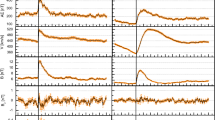Abstract
We examine chromospheric oscillations in both a coronal hole (CH) and a quiet Sun (QS) region, by employing Transition Region and Coronal Explorer (TRACE) and Big Bear Solar Observatory (BBSO) data on September 14 and 16, 2004. For the CH, the average oscillation periods of network magnetic field and non-magnetic field (NMF) regions are 257 and 222 s, respectively, and the average period of network field is longer than that of NMF region by 15.8%. In the QS, the average oscillation period is the 225 s for network field and 212 s for the NMF region. The average period of the network field is also longer than that of the NMF region by 6.1%. For the network region, we find that the average period in the CH is longer than that in the QS by 14.2%. This difference between CH and QS is possibly caused by different magnetic configurations i.e. the open magnetic field in the CH and the close field in the QS.
Similar content being viewed by others
References
Narain U, Ulmschneider P. Chromospheric and coronal heating mechanisms II. Space Sci Rev, 1996, 75: 453–509
Wikstøl \( \mathbb{O} \), Hansteen V H, Carlsson M, et al. Chromospheric and transition region internetwork oscillations: A signature of upward-propagating waves. Astrophys J, 2000, 531: 1150–1160
Krijger J M, Rutten R J, Lites B W, et al. Dynamics of the solar chromosphere. III. Ultraviolet brightness oscillations from TRACE. Astron Astrophys, 2001, 379: 1052–1082
Zhang J, Lin G H, Wang J X, et al. Lifetime of intranetwork magnetic elements. Sol Phys, 1998, 178: 245–250
Zhang J, Lin G H, Wang J X, et al. The evolution of intranetwork magnetic elements. Astron Astrophys, 1998, 338: 322–328
Zhang J, Wang J X, Wang H M, et al. The motion patterns of intranetwork magnetic elements. Astron Astrophys, 1998, 355: 341–350
McAteer R T J, Gallagher P T, Bloomfield D S, et al. Ultraviolet oscillations in the chromosphere of the quiet Sun. Astrophys J, 2004, 602: 436–445
McIntosh S W, Fleck B, Judge P G. Investigating the role of plasma topography on chromospheric oscillations observed by TRACE. Astron Astrophys, 2003, 405: 769–777
Vecchio A, Cauzzi G, Reardon K P, et al. Solar atmospheric oscillations and the chromospheric magnetic topology. Astron Astrophys, 2007, 461: L1–L4
Handy B N, Acton LW, Kankelborg C C, et al. The transition region and coronal explorer. Sol Phys, 1999, 187: 229–260
Zhang J, Ma J, Wang H M. Comparison of magnetic flux distribution between a coronal hole and a quiet Sun region. Astrophys J, 2006, 649: 464–469
Ireland J, Walsh R W, Harrison R A, et al. A wavelet analysis of active region oscillations. Astron Astrophys, 1999, 347: 335–365
Author information
Authors and Affiliations
Corresponding authors
Additional information
Supported by the National Natural Science Foundation of China (Grant Nos. G10873020, 10603008, 40890161, 10703020, 40674081, and 10703007), the CAS Project (Grant No. KJCX2-YW-T04), and the National Basic Research Program of China (Grant No. G2006CB806303)
Rights and permissions
About this article
Cite this article
Song, Q., Zhang, J. Chromospheric oscillations observed with BBSO and TRACE. Sci. China Ser. G-Phys. Mech. Astron. 52, 1718–1722 (2009). https://doi.org/10.1007/s11433-009-0217-8
Received:
Accepted:
Published:
Issue Date:
DOI: https://doi.org/10.1007/s11433-009-0217-8




